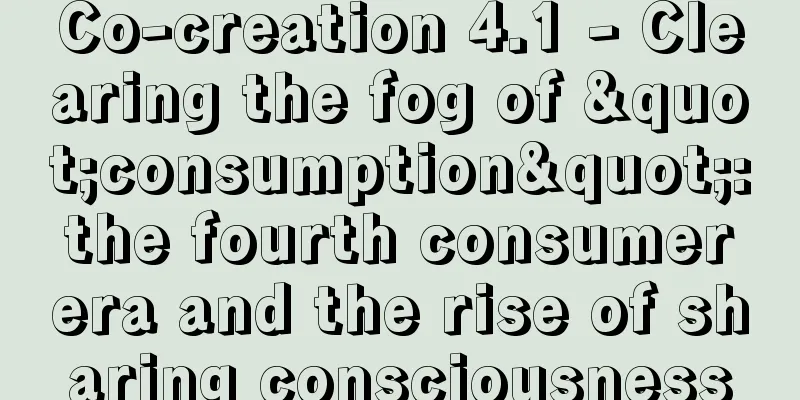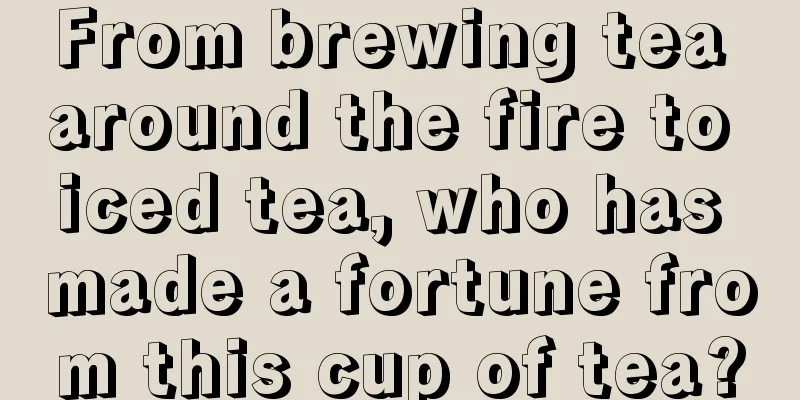Co-creation 4.1 - Clearing the fog of "consumption": the fourth consumer era and the rise of sharing consciousness

Concepts such as consumption, consumers, consumer society, consumer market, consumption trends, consumption upgrade/downgrade, consumerism, new consumption, etc. are everywhere, but do you really understand what "consumption" is? Why is it necessary to study “consumption” when studying “sense of co-creation”? The answer is simple. If we do not understand “consumption”, how can we see through the fog of new consumption and find a secure future? This article takes a micro approach and discusses consumption, consumption characteristics and future trends at six levels.
Today, let’s first look at what “consumption” is and the evolution and advancement of Japanese consumption. In the next section, we will re-understand China’s new consumption. 1. What is “Consumption”? — Baudrillard, Kevin Kelly, Sanpo Miura and China’s Generation ZSince the word consume appeared in English in the 14th century, its meaning has been constantly evolving. "Con" means "all" and "Sume" means "take". In the early days, people mainly consumed food, so "consume" meant "use up", "burn up", "eat up", "drink up", and later extended to negative meanings such as destroy, waste, and exhaust. Since the 18th century, "consume" has entered bourgeois political economy with a neutral attitude, but its negative meaning has not completely disappeared. In fact, it shows a critical stance, that is, the observation and criticism of a wasteful and extravagant social living situation. With Baudrillard, "consumption" becomes very different. 1. Baudrillard’s foundation: “Consumption” is a symbolic attributeIn 1970, French sociologist Jean Baudrillard published Consumer Society, a landmark work. Baudrillard points out in his book:
To rephrase this in modern language:
The theory of 1970, how powerful! 2. Kevin Kelly’s new understanding of “consumption” – from “ownership” to “participation”Futurist Kevin Kelly believes that the development of technology and the Internet has brought about tremendous changes in our consumption habits, and consumption is shifting from traditional "ownership" to "participation." People are no longer just passive recipients of goods and services provided by businesses, but have become creators, co-creators and participants. He calls this phenomenon the "sharing economy."
These forces are not destiny, but trajectory. They do not provide predictions about where we will go. They simply tell us where we will go in the near future, inevitably. 3. Sanpu Hideki’s new thinking: “Consumption” is achievement and free pleasureJapanese sociologist Hidetoshi Miura has new thoughts on consumption in "The Fourth Consumer Age". Sanpu Hideki believes that there is another word similar to consume, Consummate. Here, "Com" means "all", "Sum" means "total", and as a verb "Consummale" means to complete, realize, and achieve.
Consomation in French also means " completion" and "achievement" . In addition, Sanura Hideki believes that the key point is the derivative word "Consumatory" of Consummate, which is an important concept in sociology. It is translated as "self-sufficient" and can be extended to mean that the emotion brought by art and "my heart leaps with joy when I see the rainbow" can be achieved without any means. This gives us a completely new insight - the word "consumption" not only means "use up, consume"; it also includes "accomplishing perfect achievement"; a stronger inference is that "consumption" also means "a kind of free pleasure without any means." Finally, Sanpu transformed his ideas into a clear theoretical system - "The Fourth Consumer Era" (details later) 4. Interpretation of "Inspiration" - "Consumption" is a kind of meaningful consumptionIn "Inspiration", Luo Zhenyu expanded on "consumption" and "consumerism" to a certain extent. Scholar Xu Zhiyuan said, "Our society today is not actually short of material things, but short of meaning. The vast majority of consumption is actually consumption of meaning and identity." Many people buy books but don’t read them, and this is actually the reason. For example, if you notice a book and really like the title, you buy it. Once you get it, you feel satisfied with the meaning of owning the book, and your interest in the book ends. Therefore, Luo Zhenyu and others believe that possession itself is the realization of meaning, which may be the biggest secret of the new consumption era. So what is consumerism? It is not about being lazy and extravagant, but about using consumption to solve the problem of lack of meaning. For example, I buy an iPhone or a bag to prove that I am something. How can this be considered buying something? This is buying a meaning; in turn, it proves that I don’t have the ability to create meaning myself, and I need to buy something ready-made. This is called consumerism. For the same thing, some people see it as consumption, while others see it as an investment. 5. Generation Z and Generation Alpha have different pursuits: “Consumption” is a kind of life sovereigntyWith the collision and integration of digitalization, technology and ideas, Zygmunt Bauman's "liquid society" and the era of individualization have arrived. Liquid society provides the basis for free flow, mutual connection, and loosening up at any time; individualization means that individuals break away from traditional collective social relations and structures, have complete personal rights, and can make independent decisions and shape their own lives. In other words, you can finally decide for yourself what kind of person you want to be and what kind of life you want to live. Therefore, these new humans have different pursuits for "consumption": from passive consumers to active people, evolving from consumer sovereignty to life sovereignty (the following is quoted from "Super Sense Recode").
This is also the underlying reason why you can see various small utopian communities, self-sufficiency, wild teachers, returning to hometown to start a business, planting trees in the desert, lying down across the country, Citywalk, dopamine happiness and other small interest explosions and "Night Parade of a Hundred Demons" today. More importantly, these new humans view the meaning of "consumption" not only as "owning and obtaining", but also as emotional satisfaction, life testimony, self-construction, etc .; they actively use "consumption" as a way and force to intervene in various social issues, and bring positive changes to society through practical actions. Now, do you know what "consumption" is? Maybe you are more confused, which is right, because you begin to think about the nature and meaning of "consumption". However, no matter whether "consumption" refers to "symbolization of objects", "achievement and pleasure", "participation and sharing", "meaning and identity" and "life sovereignty", "consumption" is no longer just about buying and using. It has unprecedented charm and unlimited imagination, and also means a better future. 2. Miura's four consumer eras and changes in consumer valuesBrand Ape believes that among the many social consumption studies, if you want to have a more thorough understanding of China's consumption changes, trends and possible future, you only need to read "The 4th Consumer Age" published by Sanpu Hideo 10 years ago: on the one hand, you can read China's 50 years of consumption changes in the phenomenal world, and on the other hand, you can continuously explore the underlying logic of consumption changes from a rational perspective. Sanpu Hideki divides Japan's consumption since the Industrial Revolution into four eras based on time, characteristics and attitudes : 1. The First Consumer Society (1912-1930)Consumption background: prosperous economy and rising country. The Takarazuka Revue was founded in 1913; Japan's first station department store opened in 1920; the Shiseido chain opened in 1923; Suntory Whisky/Tiger thermos bottles were put on the shelves. Main group: consumption by the rich and a small number of middle class. Consumption orientation: high-end, westward. Consumption values: Private consumption that emphasizes status. Benchmarking China: 10 years after the reform and opening up, those born in the 1960s consumed the four major items and became the first group to get rich. 2. The Second Consumer Society (1950-1974)Consumption background: economic revival, rapid growth, and reshaping of national mentality. 1964 Tokyo Olympics; 1966 Toyota Corolla mass production "first year of private cars"; 1968 China became an economic power second only to the United States; 1970 Osaka World Expo. Main population: 100 million people are becoming middle class. Small families and young housewives are appearing in large numbers. Consumption orientation: larger consumption (bigger is better, large items, tendency towards big cities) and family consumption (pursuing a society symbolized by private homes and private cars). Consumption values: Emphasis on private consumption for family and society. Benchmarking China: accelerated urbanization, consumption by those born in the 1970s, the housing boom from 1998 to 2008, and the emergence of the middle class. 3. The Third Consumer Society (1975-2004)Consumption background: economic bubble, population explosion, widening disparity, and financial reform. 7-11 convenience store in 1974; Sony's first cassette player in 1979. Main groups: Singles born during the economic boom (freelancers), popular for individual food (eating alone/instant noodles/instant coffee), late marriage is popular. Consumption orientation: European and American brands, high-end luxury fashion .
Consumption values: Emphasis on personal private consumption. Benchmarking China: New e-commerce retail started in 2008; personalized and self-pleasing national trends, etc.; the main consumers are the new middle class and those born after 1990. 4. The Fourth Consumer Era (2005-2034)Consumption background: The economy has been in a long-term recession. Population is decreasing, consumption is shrinking, and housing problems are becoming more prominent. MUJI, UNIQLO and Tsutaya Books were born. Main group: Single individuals of all ages. Consumption orientation: simplicity, leisure, and lifestyle tendencies; Japanese and local tendencies; the birth of sharing consciousness.
Consumption values: transforming consumption into a process of self-enrichment and pursuing consumption with the meaning of life. Benchmarking China: Starting from 2020, the Chinese romance of the Winter Olympics; the new poor and refined poverty; involution and lying flat; challenges and anxiety, yearning and action, and the pursuit of green environmental protection and sustainability. Core groups: post-95s, Generation Z, and digital natives.
If you look closely, you will be pleasantly surprised to find that Miura's four consumer eras perfectly echo China's development over the past 50 years, especially the past two years (see the next chapter). 3. The core driving force of the fourth consumer era: "sharing consciousness"Sanpu Hideki believes that the core element driving the fourth consumer era is - "sharing consciousness"! This view, in fact, inherits Baudrillard's "Consumer Society" and Alfred's "The Meaning of Life" , and is later integrated with Zygmunt Bauman's "Liquid Society" and Kevin Kelly's "Sharing Economy" . Three progressive logics help you understand Miura Sho’s "sharing consciousness". 1. What is "shared consciousness"?
In summary, a society that values "sharing" places more emphasis on the relationship between people and the relationship between people and society, and thus "social consciousness" comes. 2. From personal consciousness to social consciousness
A simpler understanding is the change from "happy" to "glad". For example, a comparison between “I went to a theme park with my friends yesterday, it was so fun” and “I was so happy to go to a theme park with my friends yesterday” shows that the focus of the latter is on the friends . The feeling of being able to meet and the level of relationship between each other cannot be experienced through happiness. Another example is the current economic consumption behavior. People will basically spend money on things they think are meaningful. Therefore, they will only be willing to spend money when they encounter something different from the past and think "this will make them happy" . In the future, we will yearn for connections between people and between people and society more and more! Image from the Internet: Beichen Youth WeChat 3. From Egoism to Altruism
Going further, altruism under "shared consciousness" is also a kind of " decentralized " consciousness. This kind of local consciousness and circle consciousness will inevitably produce anti-centralization and anti-authoritarian consciousness, which corresponds exactly to Kevin Kelly's point of view - the roadmap for the future: swarm thinking. In short, consumption has finally shifted from pure material consumption to consumption that focuses more on emotional experience and spiritual values. We have shifted from personal happiness to de-privatized values, spiritual happiness, and social happiness. 4. What comes after the fourth consumer era?Sanpu Hideki believes that the three characteristics of "sharing", "altruism" and "society" will evolve in depth, and enterprises and governments should assume more responsibilities:
Finally, Sanpo Miura concluded that in the future, "sharing, social responsibility and social experiment" consumption will become the mainstream of world consumption. People will provide each other with the resources they need, maximize personal interests and maximize social responsibility. 4. The reasons for the emergence of Japan’s fourth consumer era and “sharing consciousness”In order to prevent the above results from being reduced to a purely simple logical theoretical level, it is necessary to analyze the reasons for the emergence of Japan's shared consciousness. In addition to the closure of young people's channels for self-realization due to " deteriorating economic environment " , " declining fertility rate " and " accelerated aging " , there are two other important factors in the emergence of Japan's fourth consumer era: "digital society" and "consumption reflection". 1. Informatization and digitalization are the basis for the continuous expansion of sharing awareness
What are the results? More emphasis on knowledge and information acquisition; more emphasis on knowledge and cultural connotations; stronger transmission and co-construction of social awareness... 2. National reflection and consumption guidanceHideo Miura, Masakazu Yamazaki, Soetsu Yanagi, Hiroyuki Hara, Riken Yamamoto, Chizuko Ueno, Kazuo Inamori, Muneaki Masuda, Nobuhiko Tanaka, Shu Yamaguchi..., whether they were scholars, artists, musicians; or entrepreneurs, design masters, brand people began to reflect on the consumption status of Japan at that time. They dismantled, guided and changed consumption with their expertise and attitude.
The two most well-known ones are Kenya Hara and Hayao Miyazaki. Kenya Hara’s practice: “ When our minds cool down from the heat of searching for innovation with eyes wide open, and return to normal body temperature, we will have the leisure time to take a good look at the things around us.”
Hayao Miyazaki clearly pointed out in "Spirited Away" that the alien world that Chihiro broke into is actually the real Japanese society, and in fact, the bathhouse I described is Japan.
Because of the above guidance, consumers from different classes are also reflecting and even becoming more practical:
Japan's reflection on consumption is shifting from the European and American era that prioritizes material and time axes to the exploration and expansion of Eastern spiritual and spatial axes. Once you understand the reasons, the result of "shared consciousness" is obvious: it constitutes the ideological core of the fourth consumer era, and there is no more appropriate word to describe it. By the way, when Miura Hideki and others were reflecting on Japanese consumption, what were Chinese public intellectuals and experts doing: Are they enjoying wine and meat? Are they making shocking remarks? Are they trying to boost morale or to criticize Japan? Are they encouraging consumption? Are they plagiarizing? Are they cursing? Are they gossiping? Are they live-streaming? … Luo Xiang said it very well in "13 Invitations": "Many arrogant views conflict with the basic common sense of ordinary people. There is nothing wrong with technical arguments, but they conflict with people's conscience." Author: Brand Yuan, WeChat public account: Brand Yuan (ID: brand-yuan) |
<<: My card note taking method
>>: From coconut trees to hawthorn trees, why has “male sex marketing” become so popular?
Recommend
A tea brand "Yinian Caomuzhong" private domain growth case analysis, worth learning for everyone
At present, the development of the tea industry is...
2023 Revelation丨The Year of Virtual Humans
In 2023, the emergence of large models has given t...
WeChat finally came to its senses: removing the threshold for users to leave messages on public accounts and no longer forcing users to follow
For a long time, users often encountered the restr...
Three situations of three "digging and digging kindergarten teachers"
"In what kind of garden, dig and dig, what ki...
The way to play Xiaohongshu has changed again in 2024
In the business ecosystem of Xiaohongshu, many bus...
The volume of voice overshadows Douyin, and the "five high" brands should not miss the video account
This article mainly discusses the development tren...
AI "invades" content platforms, are creators ecstatic?
AI can perform repetitive and tedious tasks, there...
1 million cups sold in 10 days, the whole network is promoting the "Gingerbread Man Cup", how did it become popular?
As Christmas approaches, a gingerbread man cup has...
Xiaohongshu local store traffic surged 200%
It has become a common phenomenon for offline stor...
How much does it cost to open a cross-border e-commerce store (summary of the opening costs of AliExpress, Wish, eBay, and Shopee)
When it comes to cross-border e-commerce, platform...
Brand Growth│Brand Launch Guide
Products play a vital role for a start-up brand. U...
eBay announced its withdrawal from the French Black Friday event in 2022
In order to comply with the trend of sustainable d...
Is it illegal to transfer an Amazon store? What should I do if I want to transfer a store?
Not every merchant on Amazon has a booming busines...
Washing hair, picking up fans, and promoting each other in the live broadcast room, domestic brands must take advantage of this overwhelming wealth
Recently, the top anchor Li Jiaqi's failure ha...
It’s amazing! It turns out that the RFM model can be used in this way.
RFM is a very traditional data analysis model. How...









